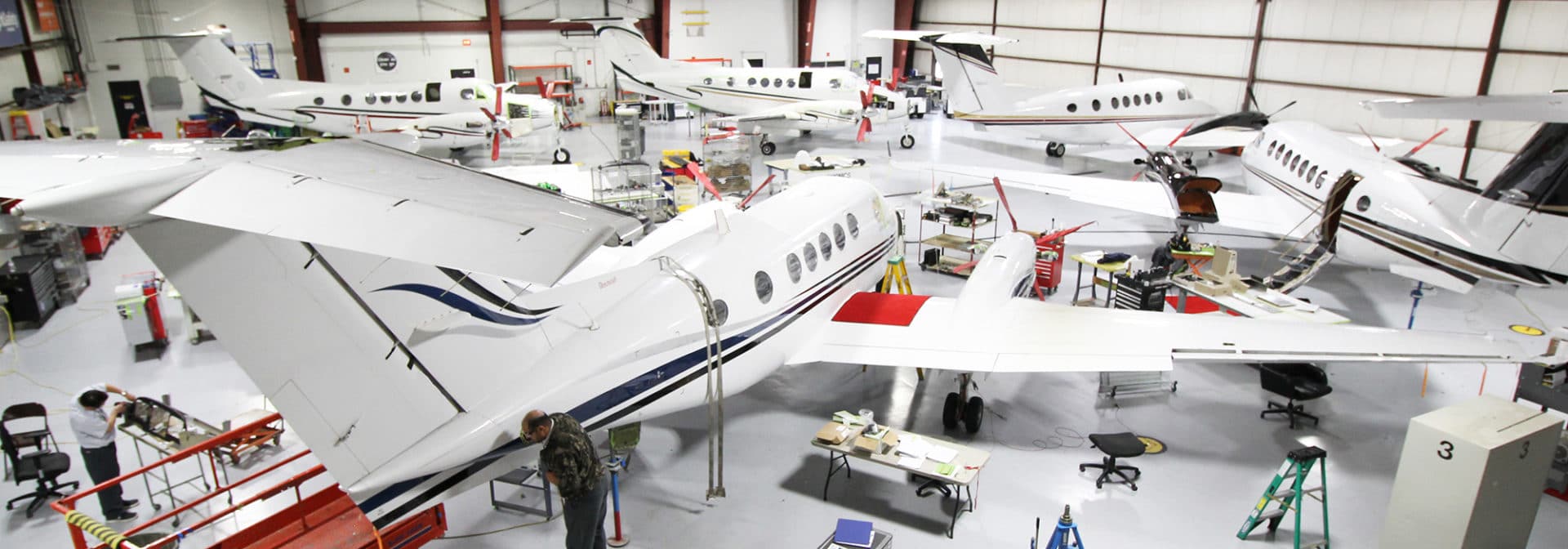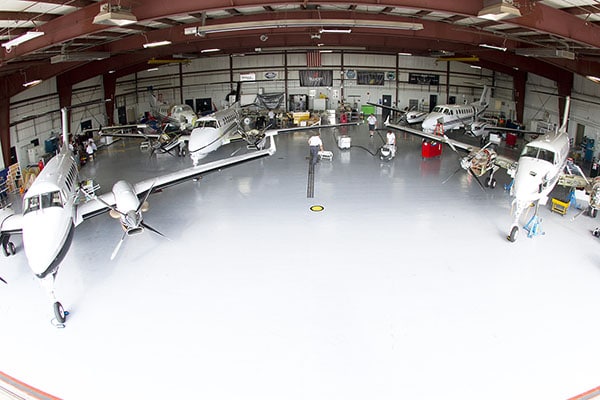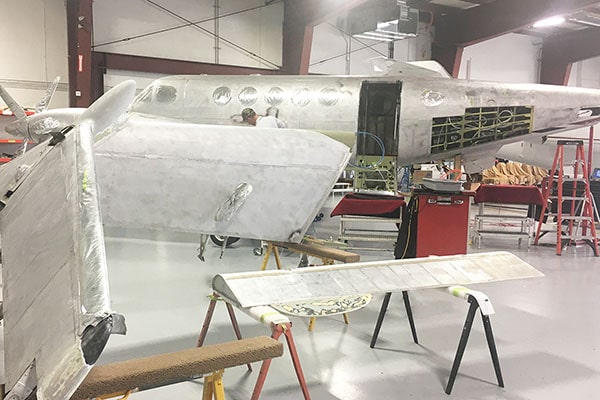King Air Maintenance – An Overview of Major Events
The King Air is one of the most successful business aircraft ever built. Initially introduced by Beechcraft in 1964, the King Air has had many variants and upgrades through the years. Fully understanding both scheduled and unscheduled King Air maintenance, as well as upgrades, should be a goal of any King Air operator. Knowing your maintenance options could increase the life of your King Air and bundling items could help you reduce downtime. Knowledge of your upgrade options can help increase the performance of your aircraft.
King Air Phase Inspections
The most common King Air maintenance item operators will encounter are Phase inspections. King Airs have four Phase inspections, a Phase 1, Phase 2, Phase 3, and Phase 4. King Air Phase inspections typically happen every 200 hours and an entire King Air series of Phase 1-4 inspections are required to be completed every 24 months. Many operators choose to combine their Phase inspections to better utilize their downtime. This is can be done when an airplane is flown less than 400 hours in a 24-month period.
During a Phase inspection, or combined Phase inspections, a King Air typically gets an inspection on the following:
- Landing gear including retraction
- Engines
- Cabin section
- Wings
- Operational components
- Rear fuselage
King Air Detail Inspections
In newer model, Pro Line Fusion equipped King Airs, the regular inspections have now been switched to what is known as a Detail inspection. Although the types of items reviewed during a Detail inspection are similar to the items that get reviewed in a Phase inspection, the intervals are different. Much like phase inspections, there are four Detail inspections: Detail 1, Detail 2, Detail 3, and Detail 4. A single detail inspection is required every 200 hours. If an operator does not fly 200 hours within a 24-month period, they are required to do a dual detail inspection. Regardless of how an operator completes their inspections, a Detail 1-4 must be completed in 48 months.
Additional Common King Air Maintenance Items:
Five-Year Wing Bolt Inspection
Every five years, a King Air wing bolt inspection is required. This includes visual and fluorescent liquid penetrant of the Inconel wing bolts and nuts. It also includes a magnified visual and eddy current as specified left and right outboard wing lower forward main spar fittings. Eddy current is also used to inspect flat surfaces, depressions, counterbores, and bolt bores at the upper forward, upper and lower aft wing attach points.
Engine Minor Inspection
An engine minor inspection is typically done in conjunction with a phase inspection and is due every 400 hours. This inspection includes:
- Replacement of fuel pump outlet filter
- Check and cleaning of the fuel pump inlet screen
- Cleaning of P3 filter drain
- Inspecting of the engine control linkages
- Check oil filter element and secondary screen
72-Month/2,500 Cycle Cockpit and Cabin Interior Inspection
The King Air 72-month/2,500 cycle cockpit and cabin interior inspection require the interior of the aircraft to be removed. The inspection includes:
- Visual inspection of the cockpit and cabin fuselage skins and structures
- Visual inspection of the environmental ducting
- Visual inspection of the electrical wiring
- Visual inspection of the plumbing
- Visual inspection of the oxygen system, components, and plumbing for damage and security of attachment
Altimeter and Pitot Static System Check
This maintenance item checks the entire pitot-static system to include:
- Leak check in the pilot and copilot pitot-static system
- Tests on the ATC transponder
- Test of EFIS display
- Inspection of the air data system
- Test of the air data computer
De-ice boot replacement
De-ice boots need regular maintenance including cleaning and proper care techniques. As the de-ice boots age, they have the tendency to crack and weather to the point where they need replacement. When a de-ice boot needs replaced, there are PMA and factory parts options.
Right and Left Engine Flammable Fluid Hose Replacement
Each engine contains 15 flammable fluid hoses. These hoses transfer all of the flammable fluids throughout the engine compartments. Hose replacements are required to be changed every five years.
Brake Hose Replacement
The exposed brake hoses in the wheel well of the main landing gear transfer hydraulic fluid to the baking system. The brake hoses are required to be replaced every five years.
Gear Extend/Retract Hose Replacement
The exposed extend/retraction hoses of the nose and main landing gear enable the landing gear to extend and retract. They are required to be replaced every ten years.
Additional Regular Items:
- Windshield replacement
- Oxygen shutoff valve o-ring replacement
- CVR ULB battery replacement
- Rudder boost pressure regulator filter
- Fuselage stringer inspection
- Altimeter/transponder cert w/RVSM
- Emergency locator transmitter battery replacement
- Prop Balance
- Hydrostatic Test of the Oxygen Cylinder (with Regulator O/H)
- Overhaul of the LH & RH Starter Generator
Subscribe to our mailing list for monthly updates:
King Air Engine Hot Sections, Overhauls and Upgrades
Regular King Air maintenance also includes properly maintaining your engines. Hot sections are due every 1,800 hours and overhauls are due every 3,600 hours. During an engine hot section, the components that make up the hot section of the engine are inspected such as the CT shroud segments, compressor inlet, the turbine blades, and more. This inspection is completed to ensure that the hot section of the engine will safely and efficiently generate enough power. During an overhaul, however, all of the components of the engine are disassembled, cleaned, inspected, reassembled, and then tested. This includes components in the accessory gearbox, gas generator, power section, and the reduction gearbox.
At the time of overhaul, King Air operators have many excellent options for Blackhawk engine upgrades that could give them faster speeds, reduced time to climb, and other major benefits. Many of these options are available at prices that are competitive to engine overhauls.
Popular Blackhawk engine upgrades include the following:
King Air C90
- XP135A
King Air 200
- PT6A-42
- PT6A-52
- PT6A-61
King Air 300
- XP67A
The King Air 300 engine upgrade also includes five-bladed composite Hartzell propellers.
King Air 350
- XP67A
The King Air 350 engine upgrade also includes five-bladed composite MT propellers.
Propeller Overhaul
Hartzell propellers are overhauled every 60 months (five years)/ 3,000 hours or 72 months (6 Years)/4,000 hours depending on propeller model number, whichever comes first. When it comes time for an overhaul, King Air operators can choose to overhaul their propellers, purchase exchange propellers, or upgrade. During an overhaul, propellers are disassembled and inspected. Parts are refurbished to overhaul standards or parts are replaced and static balanced. Popular King Air propeller upgrades include Raisbeck composite 5-blade turbofan propellers, Raisbeck aluminum 4-blade turbofan propellers, Raisbeck power propellers, and BLR 5-blade Whisper propellers.
King Air 6-Year Landing Gear Inspection
The 6-year landing gear inspection is the largest type of King Air landing gear inspection. The estimated turn time on a King Air 6-year landing gear inspection is two weeks. During this inspection, the landing gear is stripped and repainted and a service leak check is performed. The following components are replaced:
- Seals
- Shimmy damper
- Drag braces
- Line-ream bushings
- Applicable placards
- Common hardware
During a King Air 6-year landing gear inspection, additional items may be needed such as:
- Removal of corrosion before re-plating
- Service bulletin upgrades
- Machining of parts
- Repair of damage resulting from negligence or improper maintenance
- Replacement or repair of major or structural parts
Raisbeck Modifications
Raisbeck makes many of the most popular airframe and engine modifications available. These include:
- Crown wing lockers
- Composite 5-blade turbofan propellers
- Aluminum 4-blade turbofan propellers
- Power props
- High flotation gear doors
- Dual aft body strakes
- Enhanced performance leading edges
- Ram air recovery
Other Upgrades:
Frakes Exhaust
The Frakes exhaust system helps to redistribute the exhaust from your engine. The primary reason for doing this is to reduce the amount of exhaust soot that comes into contact with your airplane.
LoPresti Boom Beam Lights
Another popular upgrade are LoPresti Boom Beam lights. These lights affix to the landing gear of a King Air and greatly increase the nighttime visibility on the taxiway and runway. This upgrade is particularly popular for operators that regularly fly into and out of smaller airports.
Centex Saddle Tank Conversion
The Centex saddle tank conversion is available for the King Air 90, 200, and 300 series. This upgrade provides extra fuel capacity and over-wing baggage capacity. Fuel capacity can be increased by as much as 95 gallons per tank and storage can be increased by up to 10 cubic feet per side.
Wrapping Up
Part of the reason the King Air is so popular is because the ease of maintenance and the many different upgrade options. There are also many highly capable King Air maintenance facilities throughout the world. At Elliott Aviation, we’ve been maintaining King Airs since 1964. Find out why we’re King of the King Air here.






